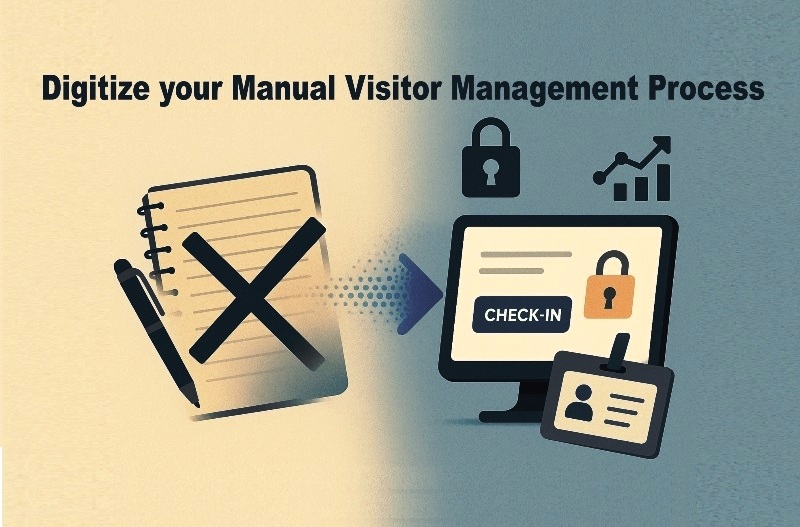Why Modern Visitor Management Software Is a Must-Have for Today’s Workplaces
Published on 5/23/2025 • Updated on 7/4/2025

In an era of heightened security concerns, stringent data-privacy regulations, and ever-rising expectations for operational efficiency, relying on pen-and-paper visitor logs just doesn’t cut it anymore. Visitor management software (VMS) transforms the way organizations welcome, track, and secure their guests streamlining check-in, enforcing legal agreements, and safeguarding sensitive data. Here’s why implementing a digital visitor management solution is no longer optional but essential.
1. Seamless, Professional Check-In
Forget the days of poorly filled sign-in sheets and jammed lobbies. A modern Visitor Management Software offers pre-registration capabilities and self-service kiosks or tablets that guide visitors through each step in seconds. Automated host notifications (via email, SMS, or app alerts) ensure teams know exactly when their guests arrive, eliminating time wasted on phone calls and manual follow-ups. The result? A smoother lobby experience that reflects positively on your brand.
2. Legally Enforceable Agreements
Paper logs rarely include formal terms and conditions or non-disclosure agreements (NDAs), leaving organizations exposed if proprietary information is mishandled. Digital systems integrate policy prompts directly into the check-in workflow, capturing e-signatures and securely storing signed documents. This creates a clear, auditable trail proving that every visitor agreed to site rules, confidentiality clauses, and safety protocols.
3. Robust Security and Screening
With built-in ID scanning, photo capture, and automated watch list checks, a Visitor Management Software proactively prevents unauthorized access. Receptionists no longer have to rely on memory or improvised security questions; the software instantly verifies identities against internal or external databases. In sensitive environments such as manufacturing plants, data centers, or R&D facilities—this level of screening is critical to protecting people, products, and intellectual property.
4. Full Data Privacy and Compliance
Open visitor books can expose names, companies, and arrival times to anyone who flips the pages an obvious privacy risk. Digital visitor logs, by contrast, store information in encrypted databases with role-based access controls. Administrators can implement retention policies that automatically purge records after a set period and honor “right to be forgotten” requests with a single click. These features help you stay compliant with GDPR, HIPAA, and other data-protection regulations.
5. Real-Time Visibility and Emergency Response
In the event of an evacuation or security incident, knowing who is in your building and where they are located can mean the difference between a contained situation and a disaster. Digital visitor systems provide up-to-the-minute headcounts and location logs accessible from any authorized device no need to scramble for binders or recount names. Some platforms even offer one-click emergency alerts to visitors’ mobile devices, guiding them safely through exits.
6. Actionable Insights and Scalability
Beyond day-to-day operations, a Visitor Management Software generates rich analytics on visitor patterns peak traffic times, frequent guests, and host responsiveness. This data helps optimize staffing, lobby layout, and security protocols. Plus, whether you have one front desk or dozens of global locations, a cloud-based system scales easily, maintaining consistency and centralized control across all sites.
In today’s fast-paced, regulated business landscape, visitor management software isn’t just a convenience it’s a strategic investment in security, compliance, and efficiency. Upgrade your check-in process, protect your people and data, and deliver a first-class experience to every guest. Call VisitorFlow Today!
- What Is Courier Management Software and Why Your Office Needs It
- Cloud-Based QR Code Visitor Management Outperforms Paper Registers and Static Desktop Software
- DPDP-Compliant Visitor Onboarding: What Security & HR Must Capture at the Gate
- Transforming Visitor Gate Passes into Legally Enforceable Visitor Experiences
- Visitor Lanyards vs. Visitor Stickers: Why It’s Time to Make the Switch
- Why use Material Gate Pass Software to Manage material Movement
- Case Study Video : Incident reporting & management software
- How QR Code-Based Incident Reporting Transforms Manufacturing Operations
- Transforming Visitor Management: Ensuring Legal Compliance and IP Protection with Cloud-Based Software
- Step-by-Step Guide to Visitor Management in Manufacturing Factories